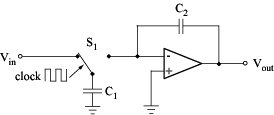 |
|
||
|
Discrete time filters (switch-capacitor filters)
o Characteristics of all active filters depend on the accuracy of their RC time constants o Typical precision achieved for integrated resistors and capacitors is more than 10% o Error of any RC time constant may be as large as 20% o Ratio of capacitor values on a chip can be accurately controlled o Switched capacitor filters use these capacitor ratios to achieve precision Key idea of Switch-Capacitor (SC) circuits: Shown on the case of an integrator
|
 Analogue filter
Analogue filter




